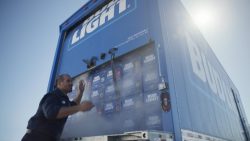Bud Light and the Light Beer Arms Race: A-B’s Best-seller Turns 35
In March 1982, Anheuser-Busch rolled out its new Bud Light in 40 states. It was the nation’s largest brewery’s long-awaited return salvo to Miller’s 1975 introduction of Miller Lite.
That beer had propelled Miller from a relative also-ran in the increasingly consolidating American beer market to the No. 2 brewery behind Anheuser-Busch, a position it (and its later iterations) would not relinquish until A-B InBev took it over last year.
A-B was not exactly looking for the same boost from Bud Light—or, “Budweiser Light,” as it was originally supposed to be called. The company bestrode American brewing like a watery colossus. Its market share was just under 30 percent, well ahead of even a surging Miller, never mind the likes of Coors and pending failures such as Stroh and Schlitz (which had lost that No. 2 spot to Miller).
What’s more, it looked like little would change. All the trends and all the analysts predicted ever more strength for the largest breweries in terms of sales and production.
In fact, the biggest threats were not from other, smaller breweries—there were only 93 breweries nationwide anyway in 1982—but from a newly resurgent American wine industry and the rocket-ship rise of vodka. Swedish brand Absolut had washed onto American shores in 1979, and was eating into every alcoholic-beverage sector, including beer.

(Photo courtesy Anheuser-Busch InBev)
And what’s now called craft or micro-brewing did not even really enter into the sales equation. That same spring of 1982 that saw Bud Light drop also saw the debut of the Great American Beer Festival. The augustly titled event drew a grand total of 24 breweries to the ballroom of the Hilton Harvest House in Boulder, Colorado. They served 47 beers, and it was over in a few hours.
So Bud Light was less a turnaround gambit than a response to Miller Lite’s rise. Or, more specifically, a further response. A-B’s releases of Natural Light in 1977 and Michelob Light in 1978—the latter, like Bud Light, was largely just a lower-calorie version of its namesake—had done little to dent Miller Lite’s hegemony in the light beer sector, one that hardly existed before 1975.
Bud Light would be different.
Before the end of the decade, A-B’s domestic market share would grow to nearly half the beer sold in the U.S., making its 30 percent at the start of the 1980s seem almost quaint. And Bud Light? That would become the best-selling beer brand in the country, and one of the biggest sellers worldwide.
Read more Acitelli on History posts.
Tom Acitelli is the author of The Audacity of Hops: The History of America’s Craft Beer Revolution and the forthcoming Whiskey Business: How Small-Batch Distillers Are Transforming American Spirits. He is at work on a biography of Michael Jackson.

Leave a Reply